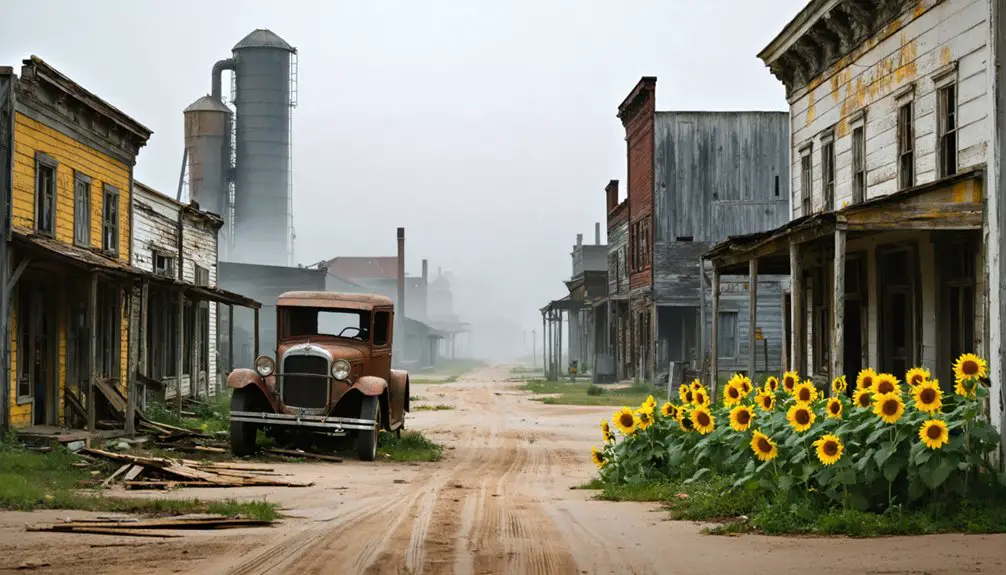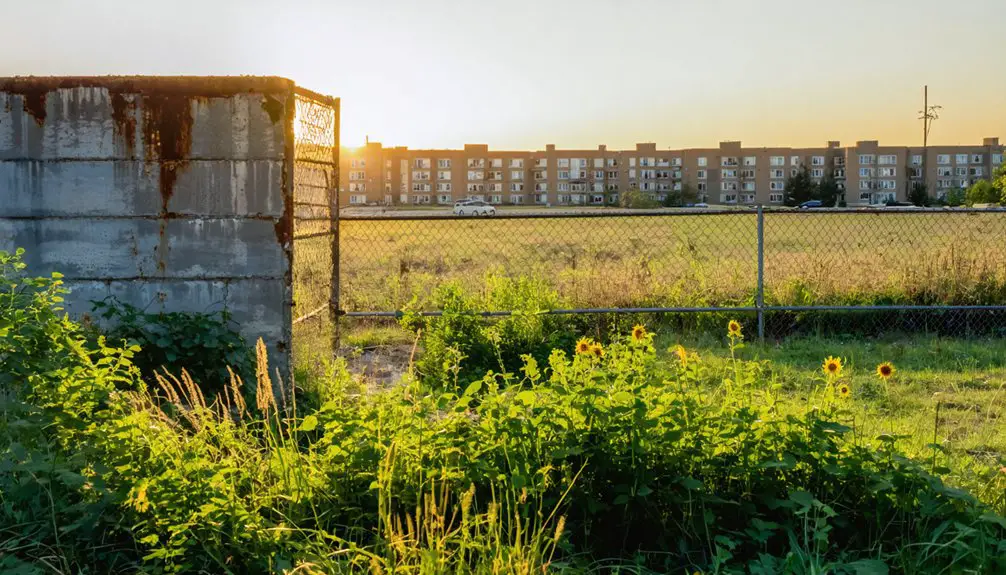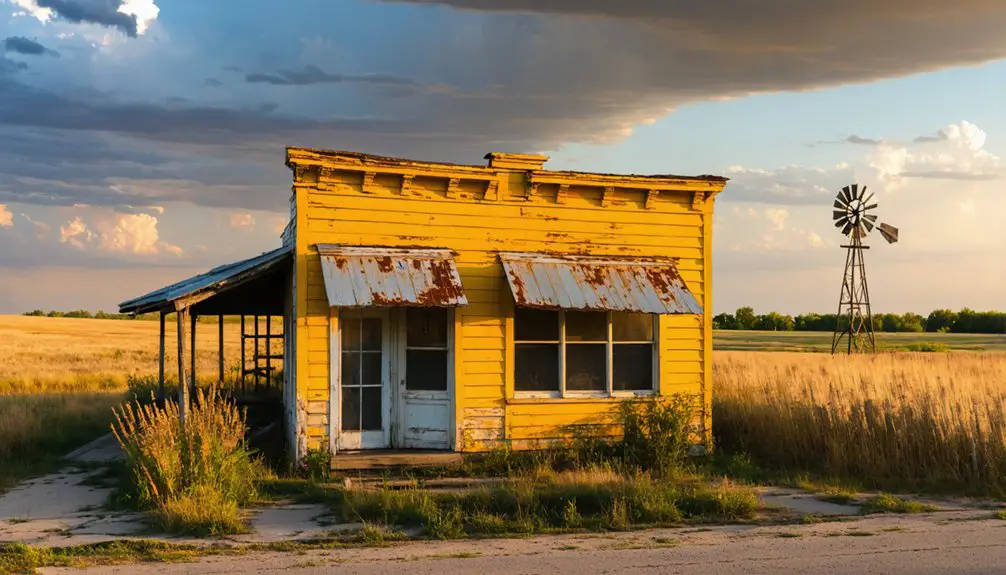You’ll discover an intriguing transformation in Sunflower Village, Kansas, established in 1943 as a wartime worker community for the world’s largest smokeless powder plant. Initially housing 1,800 residents in basic concrete block homes, it evolved into Clearview City by the 1970s and became a retirement community in 1975. After the Sunflower Ordnance Works closed in 1992, this once-bustling hub gradually faded into a ghost town, though its preserved structures still tell stories of Kansas’s wartime contributions.
Key Takeaways
- Sunflower Village transformed from a wartime manufacturing community of 1,800 residents to Clearview City, a retirement community in 1975.
- The village originally housed workers for Sunflower Ordnance Works, the world’s largest smokeless powder plant during World War II.
- After private acquisition in 1959, the federal housing complex was renovated and renamed Clearview City in the 1970s.
- The community featured basic concrete block homes, recreational facilities, and Victory Gardens during its peak wartime population.
- While not technically abandoned, the area transitioned from a bustling wartime community to a smaller retirement settlement.
From Empty Prairie to Wartime Housing Hub
When wartime manufacturing demanded thousands of workers at the Sunflower Ordnance Works in 1943, the federal government transformed 78 acres of Kansas prairie into Sunflower Village.
In 1943, wartime needs drove rapid transformation, as federal planners turned empty Kansas grassland into a bustling worker community.
Initially, you’d have found no housing plans at all – workers were expected to commute from surrounding towns like Kansas City and Lawrence. But severe housing shortages forced quick innovation.
The village’s housing designs reflected wartime innovations, following ‘Garden City’ planning principles that blended urban and rural features. Marshall and Brown architects created uniform, simple structures that could be built rapidly with rationed materials.
Despite basic concrete block construction and minimal amenities, you would’ve found a complete community within months. A vibrant village life emerged around the newspaper, church, stores, recreation hall, theater, and bowling alley.
These rapid developments proved essential, as the village became the lifeline for thousands of ordnance workers supporting the war effort. The community grew rapidly to include 800 housing units, addressing the critical need for worker accommodations.
Life in a Federal Worker’s Paradise
Inside Sunflower Village‘s boundaries, you’d find more than just hurriedly-built housing – a true community blossomed under federal oversight.
Despite the basic concrete block homes with open-shelf cabinets, worker amenities flourished. You could catch a movie at the theater, bowl with friends, or tend your victory garden. The village council guaranteed your voice was heard in community affairs. When housing became scarce, resourceful residents turned garages and coops into makeshift homes. By May 1943, 350 dormitory residents found shelter within the plant’s walls.
Community spirit thrived through sports teams, church gatherings, and social events at the recreation hall. You’d shop at local grocery and drug stores, read the community newspaper, and watch your children play in well-maintained parks.
Though initially built for 800 families, the village expanded to house 6,000 workers at its peak, transforming a vacant prairie into a vibrant, self-sustaining neighborhood where workers could live, work, and play.
The Heart of Sunflower Ordnance Works Community
A sprawling industrial powerhouse emerged in 1941 when the federal government established the Sunflower Ordnance Works on nearly 11,000 acres near De Soto, Kansas.
You’d have witnessed entire towns like Prairie Center vanishing to make way for what would become the world’s largest smokeless powder plant.
The community dynamics shaped rapidly as over 12,000 workers flooded the area.
You’ll find that wartime resilience drove the creation of Sunflower Village across Highway 10, where a self-contained community took root.
The village wasn’t part of the original plans, but necessity birthed innovation.
Workers enjoyed modern amenities including stores, schools, churches, and their own newspaper.
Under the Hercules Powder Company’s management, you’d have seen remarkable safety records and productivity, earning recognition as Kansas’s top essential war industry by 1944.
Trailer Town opened in December 1942 to house the influx of workers and their families.
The facility continued its vital role in national defense, supporting military operations through three major conflicts including World War II, Korea, and Vietnam.
Building a Self-Sustaining Village During WWII
Through rapid development in 1943, Sunflower Village emerged as a self-sustaining community built by the federal government under the Lanham Act. The wartime community quickly expanded from 800 to over 1,400 housing units by 1945, transforming 78 acres into a vibrant township supporting more than 6,000 residents. The facility played a crucial role as the Sunflower Ordnance Works produced essential military supplies and gunpowder throughout World War II.
You’ll find sustainable practices were woven into daily village life:
- Victory Gardens provided food security and social connection
- Local amenities reduced the need for transportation during rationing
- Essential services operated within walking distance
- Affordable housing guaranteed long-term community stability
The village’s Garden City-inspired design incorporated both urban and rural elements, featuring paved streets, sidewalks, and green spaces.
Residents enjoyed modern conveniences like a movie theater, bowling alley, and community center, while maintaining their independence through local food production and minimal reliance on outside resources.
Transforming From Military to Civilian Housing
You’ll find that Sunflower Village’s shift from military to civilian life began in December 1959, when Louis H. Ensley purchased 176 acres of the federal housing complex.
The extensive renovations supported a thriving community that included 852 housing units developed during the initial wartime construction period.
Under private ownership, the community underwent significant renovations, including expanded kitchens, added garages, and converted storage units to better serve civilian residents’ needs.
The transformation culminated in the 1970s when the village was renamed Clearview City and repurposed as a retirement community, marking its complete evolution from wartime worker housing to a permanent civilian settlement.
War Housing to Community
When Sunflower Village changed from federal control in 1959, new owner Louis H. Ensley transformed the temporary housing into a thriving civilian community. Under his management, the village gained a new community identity as Clearview City, reflecting its evolution beyond its wartime roots.
The transformation included:
- Expanding kitchens and bathrooms to improve daily living
- Adding garages and storage units for modern convenience
- Installing new utility services like telephone and gas
- Reducing density while maintaining affordable housing options
The community grew organically from its military origins, peaking at 1,800 residents.
You’ll find it wasn’t just physical changes that marked this change – the establishment of a town council, churches, and schools created a true sense of belonging.
Expanding Beyond Military Needs
As Sunflower Village’s military role diminished after World War II, the community underwent significant changes to meet civilian housing needs.
You’ll find that community adaptation began in 1955 when the federal government transferred ownership to private hands, leading to extensive renovations that enlarged kitchens, added garages, and modernized bathrooms.
Civilian integration accelerated with the addition of the “New Village” in 1945, featuring 580 prefabricated units and a recreation hall.
By 1961, the renamed Clearview City housed over 1,100 residents, supported by expanded infrastructure including schools, churches, and retail establishments.
While population density decreased from its wartime peak of 1,800, you’ll notice the community remained viable through its shift to a retirement community in the mid-1970s, ultimately becoming part of De Soto in 1998.
Private Ownership Changes Everything
The 1959 sale of Sunflower Village to Louis H. Ensley marked a dramatic shift from federal control to private management. Under Ensley’s leadership, the community underwent significant transformation, including enhanced utilities and modernized housing units.
Key changes you’d have noticed during this period:
- Infrastructure improvements with Bell Telephone service and Union Gas connections
- Apartment renovations expanding kitchens and adding garages
- Population decrease from 1,800 to 1,100 as units were modified
- Community rebranding as Clearview City, culminating in its 1975 conversion to a retirement village
Despite these changes, the community retained its affordable housing mission while upgrading services.
The changeover reflected a broader shift from wartime necessity to civilian life, with private ownership steering the village toward a new identity focused on senior living.
The Birth of Clearview City

Following World War II’s conclusion, Sunflower Village underwent a dramatic transformation from military-focused worker housing to private residential development. By 1955, you’d find the once-bustling wartime community evolving to private ownership as the military’s needs diminished.
The most significant change came in 1961 when Quick Way Homes purchased the property and renamed it Clearview City, marking its evolution from industrial housing to a civilian residential area. Similar to various place name disambiguation locations across America, the area underwent significant redevelopment to meet changing community needs.
You’ll notice how the community’s character shifted as renovations began taking shape, particularly under Paul Hansen’s ownership in 1971. He transformed the dense worker housing into more spacious living quarters by expanding kitchens, adding garages, and reducing the number of bedrooms per unit.
Within two years, the population decreased from 1,800 to 1,100 residents, reflecting its new identity.
A Retirement Haven Emerges
Under new ownership in fall 1975, Clearview City evolved into a thriving retirement community, marking a distinct shift from its worker housing roots. The population decreased from 1,800 to 1,100 as living spaces were redesigned to accommodate senior activities and community engagement.
You’ll find these key improvements that transformed the village:
- Expanded kitchens and bathrooms with reduced bedroom counts for comfortable senior living
- Added garages and storage units to enhance residential convenience
- Modernized interiors with improved functionality for older residents
- Maintained attractive lawns and flower gardens creating peaceful surroundings
The reopened post office provided essential services while maintaining affordable rents facilitated accessibility for retirees. The average monthly cost of skilled nursing care remained competitive at $5,185 compared to surrounding Kansas communities.
This transformation preserved the historic character while meeting contemporary senior housing needs, establishing Clearview City as a dedicated retirement haven.
Impact on Johnson County Development

You’ll find that Sunflower Village’s rapid development transformed Johnson County from a rural landscape into a bustling wartime hub, as the region’s population swelled by over 350% in the 1940s.
When faced with severe housing shortages, residents initially resorted to converting garages and chicken coops into makeshift dwellings before the federal government constructed the planned community.
The village’s successful resolution of the wartime housing crisis later influenced Johnson County’s approach to suburban development, establishing precedents for integrated community planning and affordable housing initiatives.
Population Growth Reshapes Region
Since the early 2000s, Johnson County has emerged as Kansas’s fastest-growing region, with its population projected to reach 639,183 residents by 2025. This dramatic growth, driven by population diversity and economic challenges, has transformed the area around Sunflower Village and Clearview City into a dynamic suburban landscape.
The county’s evolution brings significant changes:
- You’ll find a median household income of $107,261, substantially higher than surrounding areas.
- Your community now represents 20.5% of Kansas’s total population.
- You’re part of a demographic shift where White (76.9%), Hispanic (9.1%), and Asian (5.1%) populations create a vibrant mix.
- Your region outpaces nearby counties, with a 9.5% growth rate since 2010.
This expansion demands strategic development of infrastructure, housing, and public services to maintain the area’s quality of life.
Housing Crisis Solutions
As Johnson County’s population surges toward 639,183 residents by 2025, a severe housing crisis threatens the region’s stability.
You’ll find the average home price has climbed to $583,833, while affordable housing options under $300,000 have plummeted by 75% since 2018.
To combat this crisis, community partnerships have emerged. Habitat for Humanity‘s leading a 14-home development at Heritage Park in Olathe, while Johnson County’s invested $2.47 million for a 50+ home affordable development.
Kansas City REALTORS® have joined the effort, volunteering their time for construction projects.
Yet challenges persist. With housing inventory down 2.9% and homes selling 20.6% faster than last year, you’re seeing increased pressure on workforce retention and economic growth.
The county’s focusing on multi-family developments and smaller homes to meet entry-level demand.
Preserving Kansas Wartime Heritage
While many wartime structures have faded into obscurity, Sunflower Village stands as a remarkable tribute to Kansas’s World War II heritage.
You’ll find this unique example of federal wartime housing has earned its place on the National Register of Historic Places, highlighting its significance in community preservation and wartime legacy.
- The Johnson County Museum’s “Citizen Soldiers on the Prairie” exhibit showcases the village’s essential role during WWII
- Historians Brenda and Michelle Spencer’s documentation efforts helped secure the village’s historic status in 2014
- The site transformed from temporary worker housing to post-war affordable homes and senior living
- You can explore 78 acres that once housed 6,000 workers and their families, complete with victory gardens and community facilities
These preservation efforts guarantee future generations will understand Kansas’s critical contribution to the war effort.
Frequently Asked Questions
What Happened to the Original Furniture Provided in Sunflower Village Housing Units?
You’ll find the original furnishings’ historical significance fades into mystery after 1959, when renovations likely led to their disposal during ownership changes and unit modernization – though records don’t confirm this definitively.
Were There Any Reported Supernatural Occurrences in Sunflower Village’s History?
You won’t find any documented ghost sightings or paranormal investigations in historical records. The archives, local histories, and community documents show no evidence of supernatural activity throughout the village’s existence.
How Did Children Travel to High School From Sunflower Village?
You’d have caught designated bus routes on expanded transit lines serving your school transportation needs, while some families participated in carpools due to wartime rationing of fuel and rubber.
What Security Measures Were in Place to Protect the Village?
You’d have encountered strict security protocols including “NO TRESPASSING” signs, controlled access points, highway boundaries, and natural surveillance through Garden City design principles, while resident vetting and community watchfulness guaranteed historical preservation.
Did Any Notable Political Figures or Celebrities Ever Visit Sunflower Village?
Like a quiet meadow untouched by fame’s spotlight, you won’t find any documented celebrity sightings or political visits during the village’s existence. Records show no notable figures ever stopped by.
References
- https://romamarygrace.com/sunflower-village-war-time-housing/
- https://theclio.com/entry/147106
- https://jocohistory.wordpress.com/2013/11/12/de-soto-1942-boom-town/
- https://www.youtube.com/watch?v=G8MUl1_ZKbA
- https://legendsofkansas.com/sunflower-ordnance-works-village-kansas/
- https://www.desotoks.us/453/History
- https://en.wikipedia.org/wiki/Sunflower_Army_Ammunition_Plant
- https://krex.k-state.edu/server/api/core/bitstreams/f41e3df5-0088-4cc5-832e-eb4cfc3a63c6/content
- https://aec.army.mil/SFAAP/
- https://en.wikipedia.org/wiki/De_Soto



